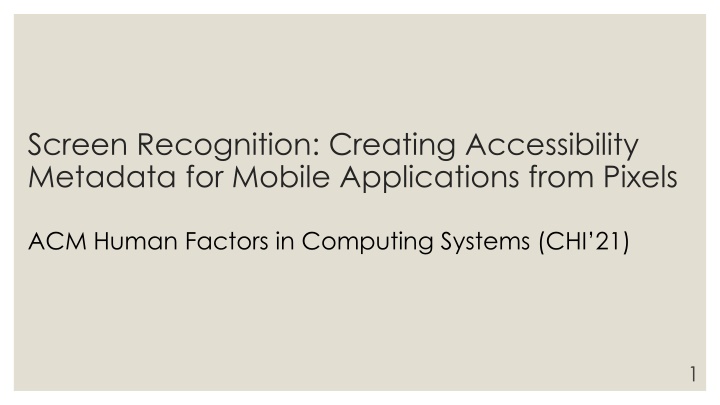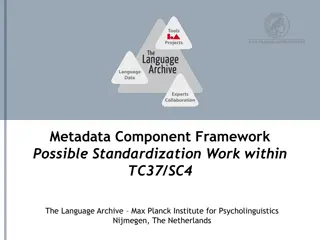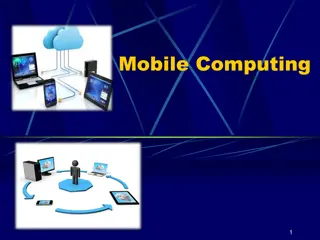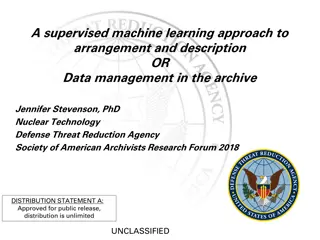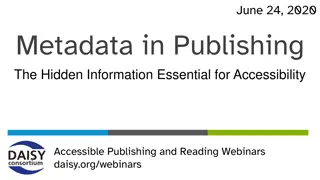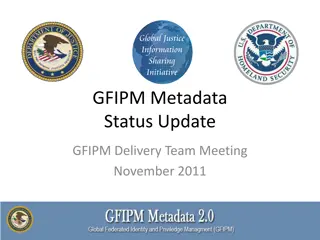Automatic Accessibility Metadata Generation for Mobile Applications
Mobile accessibility is crucial for individuals with disabilities. Lack of appropriate metadata poses challenges for developers. A new method utilizing object detection and post-processing aims to address this issue. Traditional solutions rely on manual efforts and developer engagement. Leveraging UI detection from pixel-based APIs and understanding UI semantics are key aspects in supporting mobile accessibility.
Download Presentation

Please find below an Image/Link to download the presentation.
The content on the website is provided AS IS for your information and personal use only. It may not be sold, licensed, or shared on other websites without obtaining consent from the author.If you encounter any issues during the download, it is possible that the publisher has removed the file from their server.
You are allowed to download the files provided on this website for personal or commercial use, subject to the condition that they are used lawfully. All files are the property of their respective owners.
The content on the website is provided AS IS for your information and personal use only. It may not be sold, licensed, or shared on other websites without obtaining consent from the author.
E N D
Presentation Transcript
Screen Recognition: Creating Accessibility Metadata for Mobile Applications from Pixels ACM Human Factors in Computing Systems (CHI 21) 1
Introduction Mobile accessibility means to make appaccessible to people with disabilities All of the 100 most-downloaded Android apps had basic accessibility issues The lack of appropriate metadata needed for accessibility features Developers may be unaware of accessibility Third-party UI toolkits that have limited built-in accessibility support 2
Goal Introduce a new method for providing accessibility metadata automatically from the mobile screens 1. They collected, annotated, and analyzed 77,637 screens (from 4,068 iPhone apps) 2. Trained an object detection model to extract UI elements from screenshots 3. Do some post processing to create metadata to iOS VoiceOver 3
Supporting Mobile Accessibility Traditional solutions: 1. Encouraging developers to fix accessibility problem -> slow 2. Manually labeling UI elements and forming a shared repository of such information for runtime repair -> need volunteer 4
UI Detection from Pixel API based GUI detection Visual based GUI detection: 1. Non-intrusive 2. Leverage computer vision 3. Commonly used for testing interactive software systems Traditional image processing methods (edge/contour detection, template matching) Deep learning models trained on large-scale GUI data 5
Understanding UI Semantics UI type, state, navigation order, grouping, image and icon descriptions It is important for accessibility services to know the state of an element Home Button, Clickable 6
IOS App Screen Dataset Created a dataset of 77,637 screens from 4,068 iPhone apps (i) Captured screenshots and extracted information of their accessibility trees The collected metadata has the same limitations in terms of completeness and correctness (ii) Manually annotating the visual UI elements 7
Screen Annotation Forty workers annotated all visually UI elements in the screenshots (i) Segmentation (ii)Classification In segmentation, workers determined a bounding box for each UI element In classification, workers assigned attributes to the identified UI elements 12 common UI types 8
Dataset Composition Analysis Dataset s biases between different UI types 9
Discrepancies between annotations and UI element metadata Estimate how many UI elements were not available to accessibility services 10
UI Detection Model They trained an object detection model to extract UI elements from pixels Started by experimenting with Faster R-CNN takes more than 1 second for each screen and more than 120 MB memory TuriCreate Object Detection toolkits Turi Create is an open source toolset for creating Core ML models Faster R-CNN Single Shot MultiBox Detector 11
Detecting small objects UI elements are relatively small in object detection tasks Feature Pyramid Network To improve accuracy and speed when detecting objects in different scales Data augmentation To handle class-imbalanced data 12
Other Configurations The visual appearance of Selected and Unselected Checkboxes are quite different Checkbox and Toggle: Tab Bar Item: Tab Bar Item class had good recall but low precision Split the Tab Bar Item annotations into Text and/or Icon classes 13
Evaluation and AP Result For each UI type, they evaluated model performance using Average Precision (AP) They choose a threshold of > 0.5 IoU Model achieved the lowest AP for the Checkbox (Selected) 14
Confusion matrix See how much the model misclassifies 15
Improving From UI Detection Results Even when the detections are perfect, simply presenting them to screen readers will not provide an ideal user experience as the model does not provide comprehensive accessibility metadata 16
Finding Missing UI Elements Missing data 17
Removing Extra Detections Non-Max Suppression algorithm to remove duplicate detections within these visually similar UI types Algorithm only removes spatially similar detections when IoU > 0.8 18
Recognizing UI Content We leverage some iOS built-in features to recognize content in these UI detections For Text: iOS built-in OCR engine, which provides a tight bounding box and accurate text result with a reasonable latency (< 0.5s) For Icon: Icon Recognition engine in iOS 13 (and later) VoiceOver to classify 38 common icon types For Picture: Image Descriptions feature in iOS 14 s VoiceOver to generate full- sentence alternative text 19
Determining UI Selection State Several UI types also have selection states, such as Toggle, Checkbox, Segmented Control, and Tab Button For Segmented Control and Tab Button, the most common visual indicator is the tint color They extract the most frequent color as the background color, and the second most frequent color as the tint color 20
Conclusion 1. An analysis of the characteristics (e.g., UI distribution, accessibility issues) of a large dataset of 77,637 screens (from 4,068 iPhone apps) 2. A robust object detection model to extract UI elements from raw pixels in a screenshot 3. Augmentation of UI detections for a better user experience 21
